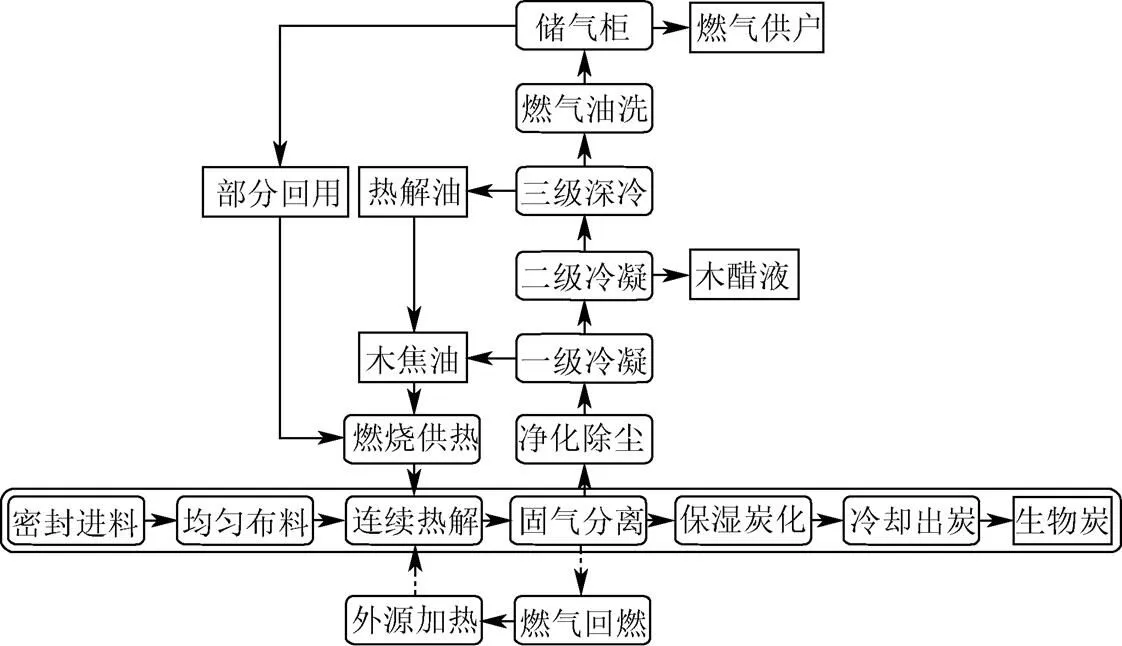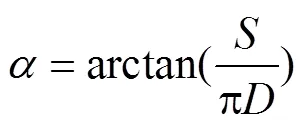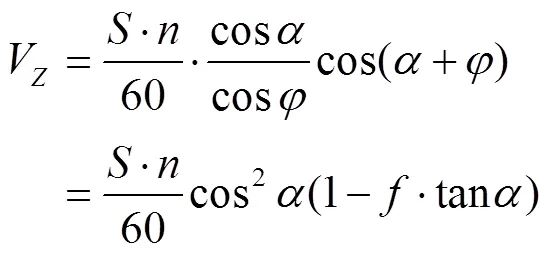生物质连续热解炭气油联产中试系统开发
丛宏斌,姚宗路,赵立欣,贾吉秀,兰 珊
生物质连续热解炭气油联产中试系统开发
丛宏斌,姚宗路,赵立欣※,贾吉秀,兰 珊
(1. 农业部规划设计研究院,北京 100125;2.农业部农业废弃物能源化利用重点实验室,北京 100125)
针对目前多数生物质炭化设备生产连续性差、能耗高、生产过程中存在焦油水洗二次污染等问题,结合生物质炭化技术最新进展和农林剩余物原料特征,提出了生物质连续热解炭气油联产工艺方案,引入连续分段热解、多级组合除尘脱焦和燃油/燃气回用加热工艺方法。在此基础上,重点突破了多线螺旋抄板物料均匀有序输送、多腔旋流梯级高效换热、保温沉降密封出炭、系统压力与气体组分耦合预警等技术,开发了生物质连续热解中试生产系统。运行检测结果表明:系统运行稳定可靠,温度控制精度为±16 ℃,反应室压力控制精度为±25 Pa,以花生壳为原料,原料处理量为28.2 kg/h,生物炭得率为31.3%,热解气产率29.6%,液体产物产率19.8%,热解气低位热值为16.3 MJ/m3,各项技术指标均达到了系统设计目标与要求。该中试系统的开发为设备放大及示范应用奠定了重要基础。
生物质;热解;炭;多联产;中试系统;开发
0 引 言
生物质炭化技术指生物质原料在绝氧或低氧环境中经加热升温引起分子内部分解形成生物炭、生物油和不可冷凝气体产物的过程,是一种生物质中低温慢速热解技术[1-3]。生物质热解多联产技术以现代生物质炭化技术为核心,通过热解气的气液分离和净化提质,生产生物炭、高品质燃气、木焦油和木醋液等多种产品。该技术具有资源利用率高、产品形式多样、二次污染少等优点。生物炭可广泛应用于固碳减排、水源净化、重金属吸附和土壤改良等,生物炭的生产和应用已引起国内外科研人员的广泛关注[4-7]。热解气作为一种清洁的高品质燃气,具有重要开发利用价值,副产物木焦油与木醋液精制后可作为重要的能源和化工原料。生物质热解多联产可进一步提高生物质资源的开发利用综合效益,符合生物质能源化资源化综合利用战略思路,具有良好的推广应用前景。
在生物质炭化技术开发方面,国内外已开发出多类反应装置,如上吸式固定床反应器、下吸式固定床反应器、循环流化床反应器、真空移动床反应器和旋转锥反应器等[8-11。生物质热裂解工艺不同,裂解气、裂解油和生物炭生成比例存在很大差异。其中,连续式生物质炭化技术具有生产连续性好、生产率高,过程控制方便、产品品质相对稳定等优点,代表了生物质炭化技术的未来发展方向[12-14]。课题组结合生物质炭化技术最新进展和农林剩余物原料特征[15],提出生物质连续热解炭气油联产工艺方案,并对相关关键技术问题进行了深入研究,开发了生物质连续热解中试生产系统,在此基础上对系统进行了性能测试。该中试系统的开发以期为生物质炭化多联产系统的放大和示范应用奠定基础。
1 工艺方案与系统组成
1.1 工艺方案
连续热解多联产技术工艺主要包括连续热解和热解气净化分离2个工艺过程,其工艺流程如图1所示。连续热解工艺主要包括密封进料、均匀布料、连续热解、保温炭化等工段,通过分段处理工艺,可有效提升产品品质和设备生产率[16]。热解气净化分离工艺主要包括除尘、多级组合冷凝、洗气等。另外,通过燃气/燃油回用燃烧,减少生产外部输入性能源消耗并保障清洁生产。
1)密封进料:是指将原料从料仓输送至炭化设备料斗内,并采取必要措施保障进料时系统的密封性[17]。物料喂入时要尽量减少空气带入量,保证反应室内的低氧和微正压工作环境;物料喂入后,要通过适时启停上料机构将物料保持在一定的高度区间,达到设备进料密封的目的。
2)均匀布料:指将料斗内物料尽可能均匀的推送至炭化设备反应室内。原料喂入的均匀一致性,对连续热解设备运行稳定性和生物炭品质均会产生重要影响。另外,均匀布料工序要求相应机械输送系统对不同类型和粒径的原料具有比较广泛的适应性。
3)回转热解:是工艺系统的核心,在回转反应室内物料翻转前进,同时在外部热源的作用下受热分解,该过程中物料主要经历干燥脱水、受热裂解2个过程,分段连续式的热解过程,对于提升设备生产效率,改善生物炭品质均有积极影响[18-20]。
4)保温炭化:指受热分解后的生物炭不直接排出,而是在系统内继续保温熟化一段时间。保温熟化的生物炭一般经过序批的形式输送至冷却出炭系统。另外,保温炭化工艺使回转热解与冷却出炭工艺分开,可避免或减少因焦油骤然冷却而附着在生物炭上。
5)冷却出炭:经保温炭化后产出的高温生物炭需要适当冷却,以防止出炭后与空气接触而自燃;此外,出料时一般需采取必要的密封措施,尽量减少空气从出炭口混入热解系统,影响系统运行安全性和产品品质。
6)净化分离:热解气净化分离部分可采用旋风除尘、多级冷凝和洗气等组合除尘脱焦技术工艺,对热解原始气进行净化分离,可有效避免传统水洗工艺造成的焦油二次污染问题。
7)回用加热:经净化除尘与油水分离后,热解副产品主要包括可燃气体、木焦油、木醋液等。回转热解采用的外部热源由木焦油和部分热解气回用燃烧提供,或由热解原始气直接燃烧提供[21-23]。

图1 生物质连续热解炭气油联产工艺流程
1.2 系统组成
生物质连续热解炭气油联产系统主要由生物质连续热解系统、热解气多级净化分离系统、燃气/燃油回用燃烧系统、序批密封上料系统、保温密封出炭系统,以及在线监测与安全预警系统等组成。其系统方案如图2所示。
设备作业时,原料经上料系统进入连续热解炭化系统反应室内,随着回转连续热解反应管的转动,物料有序翻转后移,在此过程中,逐步受热脱水、析出挥发分和裂解,然后物料继续下行,热解气与生物炭分离,其中生物炭进入保温炭化装置,在绝氧与保温环境中进一步熟化,炭化完成后,高温生物炭在螺旋输送器中适当冷却并以序批的方式从系统输出。热解气进入净化分离系统,依次进行除尘、多级冷凝和洗气,最后由增压泵打入高压储气装置中。通过压力信号的反馈,系统实时控制引风量,使反应室形成微正压炭化环境。

1.上料机 2.螺旋喂料机 3.炭化设备 4.热风炉 5.冷却出炭装置 6.防爆装置 7.金属阻火器 8.除尘器 9.一级冷凝器 10.二级冷凝器 11.电捕焦油器 12.洗气装置 13.鼓风机 14.水封阻火器
1.3 技术参数与性能指标
根据中试设备生产与工艺试验需要,生物质连续热解炭气油联产系统主要技术参数与性能指标设计如表1所示。

表1 中试系统主要技术参数
2 主要工作单元设计
2.1 回转连续式热解系统
回转连续式热解设备主要由多线螺旋板输送机构、多室旋流梯级换热系统、粉尘沉降出炭装置、传动系统和保温层等组成。多线螺旋板输送机构安装在反应室内壁,采用四线螺旋抄板主动输送物料,使物料整体向前推送过程中适度抄翻,提高物料输送的稳定性与有序性,可兼顾系统换热效率与炭化均匀性[24-25];多室旋流梯级换热系统将加热室分成4个腔,热烟气从各腔底部流过,受热气流自行上升与强制下沉组合影响,形成旋转流动过程,增强反应室换热效果。安全防爆装置采用U形水封或防爆阀门,用于因系统异常进入大量空气后出现局部爆燃或爆炸时的紧急泄压。

1.安全防爆装置 2.排烟通道 3.多室旋流梯级换热系统 4.保温层 5.粉尘沉降出炭装置 6.出气口 7.燃烧器 8.多线螺旋板抄送机构 9.传动系统
螺旋板输送机构物料输送能力与螺旋板螺距、回转反应室内径、螺旋板高度和物料填充系数等均有关系。螺旋板输送物料运动分析示意图如图4所示,物料前进速度为



式中为螺距,mm;为回转反应器内径,mm。

式中V为螺旋法线方向速度,m/s。

式中为物料牵连运行速度,m/s。

式中为回转反应器转动角速度,rad/s;为螺旋抄板回转半径,mm。为回转反应转速,r/min。
由式(1)-(5)可知,物料轴向输送速度为

物料能够向前输送的条件

式中为物料与螺旋板的摩擦系数。
由式(6)知,物料输送速度最大,即设备输送能力最强时,应满足

由于螺旋抄板具有一定的高度,在径向方向上不同位置其回转半径不同,在整个输料截面上,物料沿轴向的平均运动速度为

式中V为物料的平均轴向输送速度,m/s;1为螺旋抄板顶部回转半径,mm;2为螺旋抄板底部回转半径,mm。
因此,设备原料处理能力和在反应室的平均滞留时间可表述为


式中为物料的处理能力,kg/h;为回转反应器内径,m;为物料填充系数;为物料堆积密度,kg/m3。

注:α为螺旋角,Ve为牵连速度,Vr为相对速度,Va为绝对速度,Vn为螺旋切线速度,VZ为物料水平移动速度,φ为摩擦角,ω为回转筒转速。
对于农作物秸秆类原料设计处理能力为40 kg/h,物料在反应室的平均滞留时间为30 min,输送机构采用四线螺旋抄板设计,物料堆积密度为120 kg/m3,反应室长度为4 m,物料填充系数0.2,代入式(1)-式(11),可知反应室内径为0.4 m,螺旋抄板螺距360 mm,螺旋抄板高度为72 mm。
2.2 密封进料系统
由于炭化(干馏)技术是生物质原料在绝氧或低氧环境中受热升温引起分子内部分解的过程。因此系统需要良好的密封性。进料系统基本要求是进料的均匀性与良好的密封性。密封进料系统结构示意图如图5所示,主要包括上料仓、上料装置、喂料仓、喂料装置、扰动器,以及用于料位控制的上料位计、下料位计等组成。

1.上料仓 2.上料装置 3.喂料仓 4.上料位计 5.扰动器 6.下料位计 7.喂料装置
工作时物料经上料装置进入喂料仓内,上料机的启停受上料位计与下料位计实时信号的控制,使喂料仓内物料高度始终维持在上料位计与下料位计之间,一方面,喂料系统利用物料进行了有效密封,另一方面也避免了物料从料仓内溢出。一组扰动机构安装在喂料仓上,通过拨打物料,防止其搭桥、结拱,提高原料喂入的稳定性。另外,喂料装置转速可调,采用变螺距螺旋输送机构[26-27],提高了物料进入系统的均匀性和运行可靠性。
2.3 保温炭化与冷却出炭系统
工艺设计中,受热分解产生的生物炭不直接排出,而是在热解系统中继续保温熟化一定的时间。熟化后的生物炭经冷却装置从系统排出。保温炭化与冷却出炭系统结构示意图如图6所示,主要由沉降分离仓、保温炭化装置、冷却出炭装置、扰动器,以及用于料位控制的上料位计、下料位计等组成。
工作时,生物炭经沉降分离仓进入保温炭化装置中,冷却出炭装置的启停受上料位计与下料位计实时信号的控制,使保温炭化装置内的物料高度始终维持在上料位与下料位计之间,一方面,出炭系统利用物料进行了有效密封,另一方面也避免了生物炭料位过高溢出至沉降分离仓。一组扰动机构安装在保温炭化装置上,通过拨打生物炭,防止其搭桥、结拱,提高生物炭下行的稳定性。另外,冷却出炭装置采用间壁式循环水冷的方式将生物炭冷却到室温,防止其接触空气后自燃。

1.沉降分离仓 2.保温炭化装置 3.上料位计 4.扰动器 5.下料位计 6.生物炭水冷装置 7.出炭口 8.动力系统
2.4 热解气净化分离系统
热解气净化分离系统主要包括旋风除尘装置、多级冷凝装置、洗气装置、阻火装置和鼓风装置等,将热解气经多级组合除尘脱焦后,打入储气装置[28]。另外,在净化除尘系统中安装CO、O2、H2、CH4等在线检测装置[29],当O2含量超过设定上限时,热解气通过燃烧火炬直接排空。整个处理系统采用微正压设计,系统压力采用多点监测,根据压力信号实时控制鼓风机转速和管路中的阀门开度,使系统压力维持在设定区间。当系统压力或O2含量异常时,系统会发出预警信息,同时,燃气净化分离系统中装有安全防爆与紧急泄压等装置。
3 调试运行与系统检测
3.1 调试运行
在对系统硬件设计制造和监控软件设计开发的基础上,对生物质连续热解炭气油联产中试系统进行了运行调试,现场照片如图7所示。冷态测试结果表明,中试生产系统各运行参数均达到了设备设计要求,上料系统、出炭系统可按照设定的控制逻辑正常启停,系统运行稳定。在此基础上,对系统进行了生产性运行测试。

图7 系统调试运行现场
3.2 系统检测
以花生壳(含水率15.9%)为原料,回转反应器转速2.2 r/min,炭化温度600 ℃时[30],对设备性能进行连续性生产测试,点火时使用的燃料为柴油,系统稳定运行后通过净化分离后的热解气回用燃烧提供热解所需热量。试验过程中系统运行稳定,设备的密封效果良好,系统压力多点监测,通过管路阀门开度和鼓风机转速的适时反馈控制系统压力,系统压力可稳定维持在设定的控制区间。
对设备主要技术指标进行了测试。3次连续性生产时间均为5 h,取3次平均值得到的设备技术指标如表2所示。从表中可以看出,各项技术指标均达到了系统设计目标与要求。原料类型、粒径以及设备技术工艺参数对测试指标均有影响,不同工艺参数下的性能测试分析还需进一步试验研究。

表2 中试系统性能指标
4 结 论
1)生物质连续热解炭气油联产中试系统采用连续热解、热解气组合净化分离、热解油和热解气回用加热等技术工艺,可有效减小外部能源输入,并实现生物质连续清洁多联产,为建立适宜中国农村应用的生物质热解多联产轻简化系统提供了技术支撑。
2)生物质连续热解炭气油联产中试系统突破了多线螺旋抄板物料均匀有序输送、多腔旋流梯级高效换热、保温沉降密封出炭、系统压力与气体组分耦合预警等技术,开发的生物质连续热解中试生产系统运行稳定、工作可靠,达到了设计目标要求。
3)运行测试结果表明:生物质连续热解炭气油联产中试系统原料处理能力为28.2 kg/h,生物炭得率为31.3%,燃气热值为16.3 MJ/m3,温度控制精度为±10 ℃,压力控制精度±10 Pa,各项技术指标均达到了系统设计目标与要求,为中试设备的放大设计及示范应用奠定了基础。
[1] 李飞跃,汪建飞. 中国粮食作物秸秆焚烧排碳量及转化生物炭固碳量的估算[J]. 农业工程学报,2013,29(14):1-7.
Li Feiyue, Wang Jianfei. Estimation of carbon emission from burning and carbon sequestration from biocharproducingusing crop straw in China[J]. Transactions of the Chinese Society of Agricultural Engineering (Transactions of the CSAE), 2013, 29(14): 1-7. (in Chinese with English abstract)
[2] Shrestha G, Traina S J, Swanston C W. Black carbon’s properties and role in the environment: A comprehensive review[J]. Sustainability, 2010, 2(1): 294-320.
[3] Mašek O, Brownsort P, Cross A, et al. Influence of production conditions on the yield and environmental stability of biochar[J]. Fuel, 2013, 103(1): 151-155.
[4] 赵建宁,张贵龙,杨殿林. 中国粮食作物秸秆焚烧碳释放量的估算[J]. 农业环境科学学报,2011,30(4):812-816.
Zhao Jianning, Zhang Guilong, Yang Dianlin. Estimation of carbon emission from burning of grain crop residues in China[J]. Journal of Agro-Environment Science, 2011, 30(4): 812-816. (in Chinese with English abstract)
[5] 刘标,陈应泉,何涛,等. 农作物秸秆热解多联产技术的应用[J]. 农业工程学报,2013,29(16):213-219.
Liu Biao, Chen Yingquan, He Tao, et al. Application of cogeneration technology of gas-liquid-solid products pyrolyzed from crop straw[J]. Transactions of the Chinese Society of Agricultural Engineering (Transactions of the CSAE), 2013, 29(16): 213-219. (in Chinese with English abstract)
[6] Young Nam Chun, Seong Cheon Kim, Kunio Yoshikawa. Pyrolysis gasification of dried sewage sludge in a combined screw and rotary[J]. Applied Energy, 2011, 88: 105-1112.
[7] Park S W, Jang C H, Baek K R, et al. Torrefaction and low-temperature carbonization of woody biomass: Evaluation of fuel characteristics of the products[J]. Energy, 2012, 45(1): 676-685.
[8] 潘根兴,张阿凤,邹建文,等. 农业废弃物生物黑炭转化还田作为低碳农业途径的探讨[J]. 生态与农村环境学报,2010,26(4):394-400.
Pan Genxing, Zhang Afeng, Zou Jianwen, et al. Biochar from agro-byproducts used as amendment to cropland: An option of low carbon agriculture[J]. Journal of Ecologyand Rural Environment, 2010, 26(4): 394-400. (in Chinese with English abstract)
[9] Novak J M, Busscher W J, Laird D. L, et al. Impact of Biochar amendment onertility of a southeastern coastal plain soil[J]. Soil Science, 2009, 174(2): 105-112.
[10] 韩鲁佳,闫巧娟,刘向阳,等. 中国农作物秸秆资源及其利用现状[J]. 农业工程学报,2002,18(3):87-91.
Han Lujia, Yan Qiaojuan, Liu Xiangyang, et al. Straw resources and their utilization in China[J]. Transactions of the Chinese Society of Agricultural Engineering (Transactions of the CSAE), 2002, 18(3): 87-91. (in Chinese with English abstract)
[11] 朱华炳,胡孔元,陈天虎,等. 内燃加热式生物质气化炉设计[J]. 农业机械学报,2009,40(2):96-101.
Zhu Huabing, Hu Kongyuan, Chen Tianhu, et al. Design of an internal combustion type heating biomass gasifier[J]. Transactions of the Chinese Society for Agricultural Machinery, 2009, 40(2): 96-101. (in Chinese with English abstract)
[12] 李斌,陈汉平,杨海平,等. 上吸式生物质气化炉的设计与试验[J]. 农业工程学报,2011,27(7):270-273.
Li Bin, Chen Hanping, Yang Haiping, et al. Design and experiment on updraft biomass gasifier[J]. Transactions of the Chinese Society of Agricultural Engineering (ransactions of the CSAE) 2011, 27(7): 270-273. (in Chinese with English abstract)
[13] 何绪生,耿增超,佘雕,等. 生物炭生产与农用的意义及国内外动态[J]. 农业工程学报,2011,27(2):1-7.
He Xusheng, Geng Zengchao, She Diao, et al. Implications of production and agricultural utilization of biochar and its international dynamics[J]. Transactions of the Chinese Society of Agricultural Engineering (Transactions of the CSAE), 2011, 27(2): 1-7. ((in Chinese with English abstract)
[14] 张旭东,梁超,诸葛玉平,等. 黑碳在土壤有机碳生物地球化学循环中的作用[J].土壤通报,2003,34(4):349-355.
Zhang Xudong, Liang Chao, Zhuge Yuping, et al. Roles of black carbon in the biogeochemical cycles of soil organic carbon[J]. Chinese Journal of Soil Science, 2003, 34(4): 349-355. (in Chinese with English abstract)
[15] Zhao Ling, Cao Xinde, Mašek O, et al. Heterogeneity of biochar properties as a function of feedstock sources and production temperatures[J]. Journal of Hazardous Materials, 2013, 256/257: 1-9.
[16] 袁振宏,吴创之,马隆龙,等. 生物质能利用原理与技术[M]. 北京:化学工业出版社,2004.
[17] 徐佳,刘荣厚,王燕. 基于能量得率的棉秆热裂解炭化工艺优化[J]. 农业工程学报,2016,32(3):241-246.
Xu Jia, Liu Ronghou, Wang Yan. Optimization of pyrolysis carbonization conditions based on energy efficiency for cotton stalk[J]. Transactions of the Chinese Society of Agricultural Engineering (Transactions of the CSAE), 2016, 32(3): 241-246. (in Chinese with English abstract)
[18] 朱锡锋. 生物质热解原理与技术[M]. 合肥:中国科学技术大学出版社,2006.
[19] Foscolo P U, Germanà A, Jand N, et al. Design and cold model testing of a biomass g asifier consisting of two inter connected fluidized beds[J]. Powder Technology, 2007, 173(3): 179-188.
[20] 张春梅,刘荣厚,易维明,等. 玉米秸秆等离子体热裂解液化实验[J]. 农业机械学报,2009,40(8):96-99.
Zhang Chunmei, Liu Ronghou, Yi Weiming, et al. Experiment on plasma pyrolysis of corn stalk for liquid Fuel[J]. Transactions of the Chinese Society for Agricultural Machinery, 2009, 40(8): 96-99. (in Chinese with English abstract)
[21] 易维明,柳善建,毕冬梅,等. 温度及流化床床料对生物质热裂解产物分布的影响[J]. 太阳能学报,2011,32(1):25-29.
Yi Weiming, Liu Shanjian, Bi Dongmei, et al. Infuence of temperature and bed materials on biomass pyrolysis product distribution[J]. Acta Energiae Solaris Sinica, 2011, 32(1): 25-29. (in Chinese with English abstract)
[22] 袁艳文,田宜水,赵立欣,等. 卧式连续生物炭炭化设备研制[J]. 农业工程学报,2014,30(13):203-210.
Yuan Yanwen, Tian Yishui, Zhao Lixin, et al. Design and manufacture of horizontal continuous biomass carbonization equipment[J]. Transactions of the Chinese Society of Agricultural Engineering (Transactions of the CSAE), 2014, 30(13): 203-210. (in Chinese with English abstract)
[23] 胡艳霞,周连第,李红,等. 北京郊区生物质两种气站净产能评估与分析[J]. 农业工程学报,2009,25(8):200-203.
Hu Yanxia, Zhou Liandi, Li Hong, et al. Evaluation and analysis of net energy yield of two bio-energy stations in Beijing suburb[J]. Transactions of the Chinese Society of Agricultural Engineering (Transactions of the CSAE), 2009, 25(8): 200-203. (in Chinese with English abstract)
[24] 李定凯,孙立,崔远勃. 秸秆气化集中供气系统技术评价[J]. 农业工程学报,1999,1(1):170-174.
Li Dingkai, Sun Li, Cui Yuanbo. Technical assessment on rural cooking gas supply system straw gasification technology[J]. Transactions of the Chinese Society of Agricultural Engineering (Transactions of the CSAE), 1999, 1(1): 170-174. (in Chinese with English abstract)
[25] 乌兰图雅,王春光,祁少华,等. 揉碎玉米秸秆螺旋输送性能试验分析[J]. 农业工程学报,2015,31(21):51-59.
Wulantuya, Wang Chunguang, Qi Shaohua, et al. Test and analysis of performance of screw conveyor for rubbing and breaking corn straw[J]. Transactions of the Chinese Society of Agricultural Engineering (Transactions of the CSAE), 2015, 31(21): 51-59. (in Chinese with English abstract)
[26] 蒋恩臣,苏旭林,王明峰,等. 生物质连续热解反应装置的变螺距螺旋输送器设计[J]. 农业机械学报,2013,44(2):121-124
Jiang Enchen, Su Xulin, Wang Mingfeng, et al. Design of variable pitch spiral conveyor for biomass continual pyrolysis reactor[J]. Transactions of the Chinese Society for Agricultural Machinery, 2013, 44(2): 121-124. (in Chinese with English abstract)
[27] 王明峰,徐强,蒋恩臣,等. 生物质无轴螺旋连续热解装置送料器设计及中试[J]. 农业工程学报,2017,33(4):83-88.
Wang Mingfeng, Xu Qiang, Jiang Enchen, et al. Design and pilot test for feeder of biomass shaftless screw continuous pyrolysis device[J]. Transactions of the Chinese Society of Agricultural Engineering (Transactions of the CSAE), 2017, 33(4): 83-88. (in Chinese with English abstract)
[28] 丛宏斌,姚宗路,赵立欣,等. 自燃连续式生物质热解炭气油联产系统燃气净化分离技术工艺研究[J].可再生能源,2015,33(9):1393-1397.
Cong Hongbin, Yao Zonglu, Zhao Lixin, et al. Research on gas separation and purification technology for continuous pyrolysis system with biomass spontaneous combustion[J]. Renewabl Energy Resources, 2015, 33(9): 1393-1397. (in Chinese with English abstract)
[29] 姚锡文,许开立. 玉米芯的热解特性及气相产物的释放规律[J]. 农业工程学报,2015,31(3):275-282.
Yao Xiwen, Xu Kaili. Pyrolysis characteristics of corn cob and release rule of gas products[J]. Transactions of the Chinese Society of Agricultural Engineering (Transactions of the CSAE), 2015, 31(3): 275-282. (in Chinese with English abstract)
[30] 丛宏斌,姚宗路,赵立欣,等. 内加热连续式生物质炭化中试设备炭化温度优化试验[J]. 农业工程学报,2015,31(16):235-240.
Cong Hongbin, Yao Zonglu, Zhao Lixin, et al. Carbonization temperature optimization experiment of pilot-scale continuous biomass carbonization equipment with internal heating[J]. Transactions of the Chinese Society of Agricultural Engineering (Transactions of the CSAE), 2015, 31(16): 235-240. (in Chinese with English abstract)
Development of carbon, gas and oil poly-generation pilot system based on biomass continuous pyrolysis
Cong Hongbin, Yao Zonglu, Zhao Lixin※, Jia Jixiu, Lan Shan
(1.,100125,; 2.,,100125,)
Biomass carbonization technology refers to the process of biochar, bio-oil, and non-condensable gas products’ formation from raw biomass material. This process occurs in the anaerobic or hypoxic environment, which is a low-temperature slow pyrolysis technology. Biomass pyrolysis and multi-generation technology uses modern biomass carbonization technology as the core. Bio-carbon, high-quality gas, wood tar and wood vinegar and other products are produced through the separation and purification of pyrolysis gas. Biochar can be widely used in carbon sequestration, water purification, heavy metal adsorption and soil improvement. Thus, biochar production and application have attracted wide attention of domestic and foreign researchers. Pyrolysis gas has an important development and utilization value as a high-quality clean gas. With the advantages of high utilization rate of resources, diversified product forms and less secondary pollution, this technology can further improve the development and utilization of comprehensive benefits. It also meets the strategic thinking on comprehensive utilization of biomass energy resources, and has a good prospect of popularization and application. Continuous biomass carbonization technology represents the future development direction of biomass carbonization technology, with the advantages of good production continuity, high productivity, convenient process controlling and relatively stable product quality. In view of the fact that most of the biomass carbonization equipment has poor continuity, high energy consumption and secondary tar pollution, the carbon, gas, and oil co-production process scheme was put forward. Combined with the latest development in the biomass carbonization technology and the raw material characteristics of agricultural and forestry residues, continuous segmentation pyrolysis, multi-stage combined dust removal and fuel/gas reuse heating process methods were used. Based on it, the technologies of evenly and orderly multi-level screw board material delivering, efficient multi-cavity swirl cascade heat transferring, insulated settled and sealed char launching, with system pressure and gas component coupling early warning obtained the breakthrough. In addition, biomass continuous pyrolysis test production system was also developed. When this equipment worked, the raw material was orderly reversed with the rotation of continuous pyrolysis reaction tube in the reaction chamber. Dehydration, volatile precipitation and cracking reaction occurred during this process. As the material fell down, the biochar was separated from the gas. The biochar entered into thermal insulation device and was further carbonized in the oxygen and heat insulation environment. After being cooled down, the production was sequentially output through the screw conveyor. As for the pyrolysis gas, it was transferred to the high-pressure gas storage device using the booster pump after the steps of dust removal, multi-stage condensation, and scrubbing. To form a micro-positive pressure carbonization environment in the reaction chamber, this system would control the air volume in real time with the help of pressure signal feedback. The result showed that the system was stable and reliable. Using the peanut shell as the raw material, its treatment capacity was 28.2 kg/h, the biochar yield was 31.3%, the gas calorific value was 16.3 MJ/m3, and the temperature control precision was ±10 ℃. All of the technical indicators reached the system design goals and requirements. In this way, the pilot system development provided the foundation for equipment amplification and demonstration applications. Biomass pyrolysis and polygeneration can further improve the comprehensive development and utilization benefits of biomass resources, in line with the comprehensive utilization strategic thinking of biomass energy, which has a good application prospect.
biomass; pyrolysis; charcoal; poly-generation; pilot system; development
10.11975/j.issn.1002-6819.2017.18.023
TK6; S216.2
A
1002-6819(2017)-18-0173-07
2017-06-27
2017-08-17
引进国际先进农业科学技术计划(948计划)“连续式生物质分段均匀炭化技术系统引进研究”(2016-X55)
丛宏斌,博士,主要从事生物质能利用技术与装备方面的研究。Email:dabinc123@163.com
赵立欣,研究员,主要从事生物质资源利用技术与政策研究。Email:zhaolixin5092@163.com

